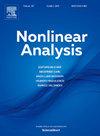Lp asymptotic stability of 1D damped wave equation with nonlinear damping
IF 1.3
2区 数学
Q1 MATHEMATICS
引用次数: 0
Abstract
In this paper, we study the one-dimensional wave equation with localized nonlinear damping and Dirichlet boundary conditions, in the framework, with .
We begin by addressing the well-posedness problem, establishing the existence and uniqueness of weak and strong solutions for , under suitable assumptions on the damping function.
Next, we study the asymptotic behaviour of the associated energy when , and we provide decay estimates that appear to be almost optimal compared to similar problems with boundary damping.
Our work is motivated by earlier studies, particularly, those by Chitour, Marx and Prieur (2020), and Haraux (1978). The proofs combine arguments from Kafnemer, Mebkhout and Chitour (2022) for wave equation in the framework with a linear damping, techniques of weighted energy estimates introduced in Martinez (1999), new integral inequalities for , and convex analysis tools when .
一维非线性阻尼波动方程的Lp渐近稳定性
在p∈[1,∞]的Lp框架下,研究了具有局部非线性阻尼和Dirichlet边界条件的一维波动方程。我们首先解决适定性问题,在适当的阻尼函数假设下,建立p∈[1,∞)的弱解和强解的存在唯一性。接下来,我们研究了当p∈(1,∞)时相关能量的渐近行为,并且我们提供了与具有边界阻尼的类似问题相比几乎是最优的衰减估计。我们的工作受到早期研究的启发,尤其是奇图尔、马克思和普里埃尔(2020)以及哈罗(1978)的研究。这些证明结合了Kafnemer, Mebkhout和Chitour(2022)对线性阻尼Lp框架下波动方程的论证,Martinez(1999)引入的加权能量估计技术,p>;2的新积分不等式,以及p∈(1,2)时的凸分析工具。
本文章由计算机程序翻译,如有差异,请以英文原文为准。
求助全文
约1分钟内获得全文
求助全文
来源期刊
CiteScore
3.30
自引率
0.00%
发文量
265
审稿时长
60 days
期刊介绍:
Nonlinear Analysis focuses on papers that address significant problems in Nonlinear Analysis that have a sustainable and important impact on the development of new directions in the theory as well as potential applications. Review articles on important topics in Nonlinear Analysis are welcome as well. In particular, only papers within the areas of specialization of the Editorial Board Members will be considered. Authors are encouraged to check the areas of expertise of the Editorial Board in order to decide whether or not their papers are appropriate for this journal. The journal aims to apply very high standards in accepting papers for publication.

 求助内容:
求助内容: 应助结果提醒方式:
应助结果提醒方式:


